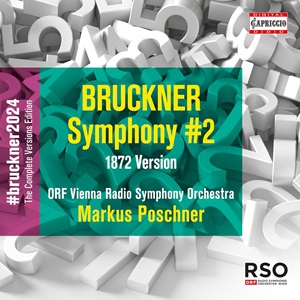
Anton Bruckner (1824-1896)
Symphony No 2 in C minor, WAB 102 (original, 1872 version, ed. William Carragan)
ORF Vienna Radio Symphony Orchestra/Markus Poschner
rec. 2023, Radio Kulturhaus, Vienna
Capriccio C8093 [61]
This is the second version of Bruckner’s Symphony No 2 to be released within the Bruckner2024 series; the first was the later, 1877 version edited by Paul Hawkshaw, which I previously favourably reviewed. Here, among other changes, as against what we more normally hear in the more frequently performed later version, the first movement is considerably longer and its conclusion is much more hectic, there is a horn rather than a clarinet solo at the end of the Adagio – which is not yet designated “Andante” – and the first B section has not yet been deleted. The repeats in the Scherzo have not yet been excised, thereby shortening it by half, and the two passages in the middle of the development of the coda of the finale are yet to be shortened and rewritten. Consequently, this is nine minutes longer than Poschner’s 1872 version, but does not begin to approach Ballot’s 84 minutes. It is in fact overall on a par with Blomstedt’s recording of the same version on the Accord label, which I found to be perfect – except Poschner is markedly swifter in the Scherzo. I have previously remarked upon his penchant for speediness, which in my estimation has had variable results. However, the recent trend in Bruckner playing as exemplified by conductors such as François-Xavier Roth in his own Bruckner cycle on Myrios Classics, is to eschew slow, “monumental” Bruckner and go for a more propulsive effect. I am not so conservative in my tastes as to reject that approach when the results are aesthetically cohesive.
Furthermore, despite editor William Carragan maintaining that Bruckner’s first intention was to place the Scherzo before the Adagio, series editor Prof. Paul Hawkshaw tells us that Poschner has here opted to retain the more usual Adagio-Scherzo order, even though he is playing Carragan’s edition of the score. Prof. Hawkshaw concludes his note by quoting Robert Simpson as saying that the symphony “is too little known”, then adding his own comment: “especially in this version.”
Of course, the debates surrounding which versions of Bruckner’s more revised symphonies are “best” will never be resolved. For example, even if most Brucknerians seem to favour the so-called “Linz” edition of the First, the original 1873 version of the Third seems still to be in the ascendant. But it is good to have the option of the two recordings of the Second in this series. They are indeed sufficiently different to merit the attention of the average punter, such as I. Having already come to love the symphony in its later, more familiar form, I do not feel strongly about the issue and am happy simply to consider this recording on its merits.
The opening is predictably urgent before we relax into the Alpine stroll of the second subject; the playing of both is crisp and alert with nicely sprung rhythms. The original conclusion is thrilling and I am happy to hear it so vigorously executed. The Adagio certainly has more of an “Andante” feeling about it, proleptic of Bruckner’s later revision of tempo marking, and I am happy to sit back and enjoy the repeat of Bruckner’s fluid melodies. The building of tension from around eleven minutes to the end of the movement is carefully managed and brings out all its lyrical beauty; the final bars with the original horn solo are magical. The Scherzo is hard, sharp and biting and makes a telling contrast to the transcendence of the preceding movement. The trumpet soloist is a star. The finale is of a piece with Poschner’s approach: driven, exhilarating, yet suitably relaxed in the slower, more songful sections.
Little needs to be said about the excellence of the engineering here; the sound throughout this cycle has been exemplary. This is a worthy addition to the series.
Ralph Moore
Help us financially by purchasing from



















